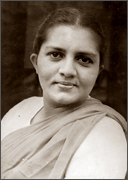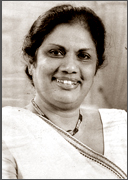Women and politics
Lal Hewapathirana
As usual, and as it happens every year on March 8, the International
Women’s Day dawned this year too. And as usual, many a function and
celebrations were held to mark the occasion. Also as usual, topics of
equal rights, equal opportunities, women and violence, women and
conflicts, women and their working conditions, and much more were widely
discussed by all interested in gender issues, and the discussers
included a variety of champions belonging to reputed non-governmental
organisations in the city, down to the most humble woman leader in a
small women’s society in the village.
|
South Asian
women Parliamentarians |
* India 8.8 percent
* Nepal 5.8 percent
* Pakistan 20 percent
* India preparing to increase to 33 percent
* Sri Lanka expects 10 percent women MPs |
Still as usual, by the following day, everything that was discussed
24 hours earlier was well forgotten by the advocates of women’s
liberation as well as the very women suffering due to abuse of their
rights, and again as usual, the society of Sri Lankan citizen returned
to square one, as if nothing had happened on the previous day - the
International Women’s Day.
Gender issues
Commencing in the USA, the world has been celebrating this important
day for 100 years now. Just fifteen years ago, an important women’s
conference was held in Beijing, at which hundreds and thousands of
important Sri Lankan women participated to draw up an important
declaration and a plan of action to address many important gender
issues, with focus on positive advancement of the status of women, who
are denied of their rights and privileges.
While new ground has been broken in some aspects of the issue during
the past five to six years through the sponsorship of the government, it
is a pity that those denied women themselves question why they have not
become stakeholders of more tangible achievements considered as success
stories of women’s emancipation, even fifteen years after Beijing.
Perhaps, the non-governmental Beijing participants may be able to
answer.
However, in the above backdrop, one voice was clearly heard on a
highly important and very pertinent topic raised by one of our most
illustrious women leaders, during the United Nations International
Women’s Day celebrations held in Colombo. She is the former Vice
Chancellor of the Colombo University, Professor Savithri Gunasekera.
 |
 |
 |
|
Sirimavo
Bandaranaike |
Vivian
Gunawardena |
Chandrika
Kumaratunga |
Professor Gunasekera, without mincing words, said that political
representation of women in Sri Lanka must be significantly increased in
order to enhance their influence at the decision making level. She
lamented that when compared with other countries, Sri Lanka badly lacks
women’s participation in the field of politics.
Women politicians
This perception of the professor is highly important, because she was
obviously referring to the women’s participation as members of
Parliament for the purpose of influencing the pro-women decision making
and legislation process at the country’s most significant chamber of
legislation - the Parliament. Professor is probably aware that, from
time immemorial, women have been in the forefront of campaigns to send
men to Parliament.
Her statement is pertinent as we are about to exercise our right to
franchise and elect our representatives in April.
If we examine the list of women members of Parliament since the 1947
election, we come across only a few names of those who were elected to
the Parliament due to their own virtues, interest and active
participation in politics and true grass roots level leadership.
According to records, Adeline Molamure, the wife of our first speaker
in our first parliament was the first woman MP, and she was heavily
involved in the political activities of UNP Women’s League.
Later elected to Parliament were Clodagh Jayasuriya (UNP), Florence
Senanayake, Vivian Gunawardena, Kusuma Gunawardena, Thamara Kumari
Illangaratne, Soma Wickremanayake and Kusuma Rajaratne and a few others.
Though some of them were the wives of the sitting MPs, the important
factor was that they were elected by the people due to their own
performances by being engaged in local level politics, and for having
contributed vigorously towards the philosophy of their respective
political parties.
It must, however, be stated that according to available data, none of
these lady Parliamentarians seem to have contributed anything
substantial to upgrade the status of the deprived women’s community of
Sri Lanka, other than promoting their political party ideologies and
catching the votes for themselves at the expense of the poor women, for
instance women living in slums and shanties or employed in rubber
tapping or tea plucking or working in factories etc., etc.
The first phase of Mahinda Chintanaya, which President Mahinda
Rajapaksa presented to the electorate in his first Presidential Election
in 2005, strongly underlines some positive steps to support in raising
the standard of specially the disadvantaged women of the country.
Legal protection
Coupled with the themes of growth and security for children, all
women were to receive adequate social and legal protection not only for
their rights, but for their well-being as well.
Through the Child Development and Women’s Empowerment Ministry many
hitherto unexplored areas were targeted and considerable success was
achieved in terms of general uplift of the status of women in some
identified areas, while much more is in the pipeline. The trend is being
well continued with greater vigour and foresight in the Phase Two of
Mahinda Chintanaya already handed out to the electorate.
More women to work
Coming back to the point raised by Professor Savithri Gunasekera,
regarding provision of more opportunities for more women to work at
decision-making level in the Parliament as MPs, it is a sad state of
affairs to note that Sri Lanka had the lowest percentage of women MPs in
the Parliament just dissolved - a mere 5.6 percent with 13 women MPs -
when compared with other countries in South Asia, excepting for
Bangladesh, Ironically, population-wise there are more women than men in
Sri Lanka, now, and women with voting rights exceed 50 percent.
A healthy percentage of at least 10 percent of women MPs in the new
Parliament would certainly do justice to the call of the women and the
cause of the women of this country, both in terms of its fairness and
justice.
Sri Lanka will be then able to enjoy some respectable status among
its South Asian colleagues, as India has only 8.8 percent and Nepal only
5.8 percent. Only Pakistan has 20 percent. India is preparing to
increase the percentage to 33.
However, it is too late for us to anticipate for more opportunities
for women in the next Parliament as all nominations have now been closed
for the General Election in April, and it is doubtful that all women
contesting will be elected. Nevertheless, there is some room for
satisfaction, as all lists of nominations filed by the major political
parties contain names of women aspiring to become MPs.
If one were to make an analytical guess, going by the nomination
lists already filed, even the next Parliament will hardly comprise at
least six percent of women MPs.
By some chance, if it does get 6 percent or more, all advocates of
women’s rights should feel contended, for it will be history created in
Sri Lanka during President Mahinda Rajapaksa’s tenure, that the next
Parliament will have the highest percentage of women MPs ever sitting as
MPs, the majority representing his UPFA, as all predictions and
projections today are for a landslide victory for him.
National Lists
There is, however, one practical solution that would help an
increased number of women MPs to represent the over 50 percent of the
population of women in the country, if all party leaders would be
genuinely interested and committed towards the progress and the forward
march of the Sri Lankan women.
This reference is to the all powerful National List, which the three
leading contender parties have already announced. Even though it is
encouraging to observe some names of women in those lists, it should be
sincerely said that all leaders certainly would have done better by
increasing the women’s representation at least in the National Lists.
History shows that these lists are, however, not permanent, which
means if the leaders decided so, they could improve on the existing
lists. Our leaders, of course, know how to do it, and they have done it
in the past.
A cursory look at the three National Lists concerned indicate only
about nine names of women out of a permitted total of 87 names. Of them,
only four women are familiar in the electorate, namely, Swarna
Obeysekera (UNF), Malini Fonseka and Kamala Ranatunga (UPFA) and
Swinitha Weerasinghe (DNA).
Swarna Obeysekera is well-known for her role in women’s development
in particular, and it is much hoped that she will be included in the
UNF’s final list, for she is one of those who can represent women in
parliament effectively due to her wide experience in the field of women
and gender.
Both Malini Fonseka and Swinitha Weerasinghe are film stars, and
being actresses, whether they like it or not, in their careers they have
carried out the instructions of their directors for the silver screen,
only to make audiences happy.
Thus they live in a dream world far and away from reality, and still
further and away from the world of the suffering women. Of course,
Malini Fonseka could be well recognized for her many feats and the
international recognition she has earned for the Sri Lankan cinema.
Kamala Ranatunga is the most versatile of the lot, with a very
convincing record of long and prestigious service in the fields of
women’s politics as well as promotion of women’s rights through the
women’s organisation of the Sri Lanka Freedom Party. Introduced to SLFP
politics by none other than SWRD Bandaranaike in 1957, in recent times,
she contested elections from the SLFP, and was elected as a SLFP women’s
representative to the Western Provincial Council.
Women issues
Since President Mahinda Rajapaksa took over the reins of the SLFP,
she has been a tower of strength in the SLFP Women’s Organisation
working day and night for the party to win elections. Due to her power
packed oratorical skills, both in verse and pros, and being a
deep-rooted woman in politics, she has been one of the most sought after
speakers on SLFP election platforms for several decades now. Political
rivals had subjected her to violence on numerous occasions, and she was
even remanded on bogus complaints during UNP regimes.
She has fought fearlessly for over 53 years to promote the status of
rural women and to politically educate them to take up social
responsibilities. She is probably a perfect role model of a woman, who
could press for women’s place and women’s rights in any forum.
Faces and parties of women apart, the need is for more and more
competent and capable women to reach levels that would empower them to
vehemently support gender issues and vigorously promote women’s rights,
and that level is where proper decisions on women’s issues could be made
and necessary legislations could be enacted, which in this country is
the parliament.
The writer is the former Director of Worldview Sri Lanka. He is
currently a consultant in Development Media and Communication
|



